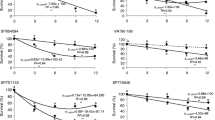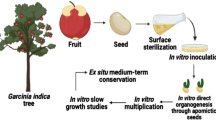Abstract
Slow-growth is a biotechnological tool for medium-term conservation of plant germplasm under in vitro conditions. In the present study, we assessed six culture media supplements and two cultivation temperatures to develop a reliable in vitro conservation protocol for ulluco (Ullucus tuberosus Caldas), an Andean tuber crop rich in carbohydrates and vitamin C. One-nodal segments of ulluco were cultivated on half-strength Murashige and Skoog (MS) medium supplemented with mannitol (10–30 g l−1), sorbitol (10–30 g l−1), sucrose (10–120 g l−1), chlorcholinchlorid (CCC; 300–700 mg l−1), abscisic acid (ABA; 1–3 mg l−1), or maleic hydrazide (MH; 0.1–0.5 mg l−1). In vitro cultures were maintained at either 5 °C or 17 °C cultivation temperature. After 18-month cultivation, based on growth characteristics, survival percentage and form of survival (plant, live shoot + microtuber, microtuber + dead shoot), four treatments were selected: 30 g l−1 mannitol|17 °C, 30 g l−1 sorbitol|17 °C, 0.3 mg l−1 MH|17 °C and 60 g l−1 sucrose|17 °C. The plantlets from these treatments were tested for regrowth ability on half-strength MS medium. After 28 days of cultivation, survival percentage and morphological characteristics were evaluated. Plantlets originating from conservation medium supplemented with 30 g l−1 mannitol showed the fastest regrowth and provided overall superior characteristics over shoots from other treatments. These plants were subjected to inter simple sequence repeat analysis, which gave rise to monomorphic patterns indicating no detected genetic variation between plants recovered after conservation on this medium and proving the reliability of this conservation protocol.
Key message
Slow-growth of ulluco plantlets at 17 °C and the use of mannitol as a culture medium supplement, represents a reliable system of conservation with minimal risk of somaclonal variation.




Similar content being viewed by others
References
Al-Qurainy F, Nadeem M, Khan S, Alansi S, Tarroum M, Al-Ameri AA, Gaafar ARZ, Alshameri A (2018) Rapid plant regeneration, validation of genetic integrity by ISSR markers and conservation of Reseda pentagyna an endemic plant growing in Saudi Arabia. Saudi J Biol Sci 25:111–116
Banasiak M, Snyman SJ (2015) Exploring in vitro germplasm conservation options for sugarcane (Saccharum spp. hybrids) in South Africa. In Vitro Cell Dev Plant 53:402–407
Bello-Bello JJ, Garcia-Garcia GG, Iglesias-Andreu L (2015) In vitro conservation of vanilla (Vanilla planifolia Jacks) under slow growth conditions. Rev Fitotec Mex 38:165–171
Bordallo PN, Silva DH, Maria J, Cruz CD, Fontes EP (2004) Somaclonal variation on in vitro callus culture potato cultivars. Hortic Bras 22:300–304
Bradai F, Sanchez-Romero C, Martin C (2019) Somaclonal variation in olive (Olea europaea L.) plants regenerated via somatic embryogenesis: influence of genotype and culture age on genetic stability. Sci Hortic 251:260–266
Campos D, Chirinos R, Gálvez Ranilla L, Pedreschi R (2018) Bioactive potential of andean fruits, seeds, and tubers. Adv Food Nutr Res 84:287–343
Cruz-Cruz CA, Gonzalez-Arnao MT, Engelmann F (2013) Biotechnology and conservation of plant biodiversity. Resources 2:73–95
Doyle JJ, Doyle JL (1989) A rapid DNA isolation procedure for small quantities of fresh leaf tissue. Phytochem Bull 19:11–15
Goncalves S, Romano A (2007) In vitro minimum growth for conservation of Drosophyllum lusitanicum. Biol Plant 51:795–798
Gopal J, Chauhan NS (2010) Slow growth in vitro conservation of potato germplasm at low temperature. Potato Res 53:141–149
Gulati R (2018) Strategies for sustaining plant germplasm evaluation and conservation—a review. RJLBPCS, Chandigarh, pp 313–320
Gurel S, Gulsen Y (1998) The effects of different sucrose, agar and pH levels on in vitro shoot production of almond (Amygdalus communis L.). Turk J Bot 22:363–373
Hammond HSD, Viehmannova I, Zamecnik J (2017) Slow-growth in vitro conservation of Ullucus tuberosus (Loz.), an Andean tuber crop. Tropentag, Bonn, Book of abstract, p 34
Hoffman I, Parups EV (1964) Mode of action of maleic hydrazide in relation to residues in crops and soils. In: Gunther FA (ed) Residue reviews/Rückstands-Berichte. Rev Environ Contam Toxicol, vol 7. Springer, New York
Holobiu IM, Catana RD, Maximilian CR, Cristea V, Mitoi ME (2018) Ex situ conservation using medium-term cultures in Moehringia jankae Griseb. ex Janka (Caryophyllales: Caryophyllaceae) and genetic stability assessment using ISSR. Acta Zool Bulg 11:155–162
Hu QJ, Fu YY, Guan YJ, Lin C, Cao DD, Hu WM, Sheteiwy M, Hu J (2016) Inhibitory effect of chemical combinations on seed germination and pre-harvest sprouting in hybrid rice. Plant Growth Regul 80:281–289
Kaminska M, Golebiewski M, Tretyn A, Trejgell A (2018a) Efficient long-term conservation of Taraxacum pieninicum synthetic seeds in slow growth conditions. Plant Cell Tissue Organ Cult 132:469–478
Kaminska M, Tretyn A, Trejgell A (2018b) Effect of jasmonic acid on cold-storage of Taraxacum pieninicum encapsulated shoot tips. Plant Cell Tissue Organ Cult 135:487–497
King RS, Gershoff SN (1987) Nutritional evaluation of three underexploited Andean tubers: Oxalis tuberosa (Oxalidaceae), Ullucus tuberosus (Basellaceae) and Tropaeolum tuberosum (Tropaeolaceae). Econ Bot 41:503–511
Koc I, Akdemir H, Onay A, Ciftci YO (2014) Cold-induced genetic instability in micropropagated Pistacia lentiscus L. plantlets. Acta Physiol Plant 36:2373–2384
Krishna H, Alizadeh M, Singh D, Singh U, Chauhan N, Eftekhari M, Sadh RK (2016) Somaclonal variations and their applications in horticultural crops improvement. 3 Biotech 6:54
Kulus D (2018) Genetic resources and selected conservation methods of tomato. J Appl Bot Food Qual 91:135–144
Lata H, Chandra S, Mehmedic Z, Khan IA, El Sohly MA (2012) In vitro germplasm conservation of high Delta(9)-tetrahydrocannabinol yielding elite clones of Cannabis sativa L. under slow growth conditions. Acta Physiol Plant 34:743–750
Leifert C, Pryce S, Lumsden PJ, Waites WM (1992) Effect of medium acidity on growth and rooting of different plant species growing in vitro. Plant Cell Tissue Organ Cult 30:171–179
Malice M, Baudoin JP (2009) Genetic diversity and germplasm conservation of three minor Andean tuber crop species. Biotechnol Agron Soc Environ 13:441–448
Malice M, Vogt V, Pissard A, Arbizu C, Baudoin JP (2009) Genetic diversity of the Andean tuber crop species Ullucus tuberosus as revealed by molecular (ISSR) and morphological markers. Belg J Bot 142:68–82
Manrique I, Arbizu C, Vivanco F, Gonzales R, Ramirez C, Chavez O, Tay D, Ellis D (2017) Ullucus tuberosus Caldas. Colección de germoplasma de ulluco conservada en el Centro Internacional de la Papa (CIP). Centro Internacional de la Papa. Lima, Peru. 445 p. ISBN: 9789290602002
Mendez M, Arbizu C, Orrillo M (1994) Niveles de ploidía de los ullucus cultivados y silvestres. Universidad Austral de Chile. Resúmenes de trabajos presentados al VIII Congreso Internacional de Sistemas Agropecuarios y su proyección al tercer milenio. Valdivia (Chile). p. 12. Agro Sur ISNN 03048802
Munoz M, Diaz O, Reinun W, Winkler A, Quevedo R (2019) Slow growth in vitro culture for conservation of Chilotanum potato germplasm. Chil J Agric Res 79:26–35
Murashige T, Skoog FA (1962) A revised medium for rapid growth and bioassay with tobacco tissue cultures. Acta Physiol Plant 15:473–497
Nasiruddin M, Islam AKMR (2018) In vitro slow-growth conservation for two genotypes of Solanum tuberosum L. Bangladesh J Bot 47:369–380
Nayak S, Kaur T, Mohanty S, Ghosh G, Choudhury R, Acharya L, Subudhi E (2011) In vitro and ex vitro evaluation of long-term micropropagated turmeric as analyzed through cytophotometry, phytoconstituents, biochemical and molecular markers. Plant Growth Regul 64:91–98
Ozudogru EA, Benelli C, Dradi G, Lambardi M (2017) Effect of culture container and carbohydrate content on in vitro slow growth storage of the cherryrootstock ‘Gisela (R) 5’. Acta Physiol Plant 39:94
Peng X, Ji Q, Wu H, Li Y (2015) Slow-growth conservation and clonal fidelity of Tetrastigma hemsleyanum plants. In Vitro Cell Dev Biol Plant 51:463–470
Pietila L, Jokela P (1990) Seed set of ulluco (Ullucus tuberosus Loz.). Variation between clones and enhancement of seed production through the application of plant growth regulators. Euphytica 47(2):139–145
Rahman MH, Islam R, Hossain M, Islam MS (2010) Role of sucrose, glucose and maltose on conventional potato micropropagation. J Agric Tech 6:733–739
Rajasekharan PE, Sahijram L (2015) In vitro conservation of plant germplasm. In: Bahadur B et al (eds) Plant biology and biotechnology, vol II. Plant genomics and biotechnology. Springer, New York, pp 419–443
Steinitz B (1999) Sugar alcohols display nonosmotic roles in regulating morphogenesis and metabolism in plants that do not produce polyols as primary photosynthetic products. J Plant Physiol 155:1–8
Tapia C, Estrella J (2001) Genetic erosion quantification in ullucus (Ullucus tuberosus Caldas), oca (Oxalis tuberosa Mol.) and mashua (Tropaeolum tuberosum R.&P.) in agrosystems of the provinces of Canar, Chimborazo and Tungurahua—Ecuador. In: Proceedings of the international symposium “Managing Biodiversity in Agricultural Ecosystems”, Montreal
Teixeira da Silva JA (2004) The effect of carbon source on in vitro organogenesis of chrysanthemum thin cell layers. Bragantia 63:165–177
Thakur S, Tiwari KL, Jadhav SK (2015) In vitro approaches for conservation of Asparagus racemosus Willd. In Vitro Cell Dev Biol Plant 51:619–625
Tyagi RK, Agrawal A, Yusuf A (2006) Conservation of Zingiber germplasm through in vitro rhizome formation. Sci Hort 108:210–219
Venezian A, Dor E, Achdari G, Plakhine D, Smirnov E, Hershenhorn J (2017) The influence of the plant growth regulator maleic hydrazide on Egyptian broomrape early developmental stages and its control efficacy in tomato under greenhouse and field conditions. Front Plant Sci 8:691
Yaseen M, Ahmad T, Sablok G, Standardi A, Hafiz IA (2013) Review: role of carbon sources for in vitro plant growth and development. Mol Biol Rep 40:2837–2849
Acknowledgements
This research was financially supported by the Internal Grant Agency of the Faculty of Tropical AgriSciences, Czech University of Life Sciences Prague, IGA (Project No. 20195002), and The Czech Ministry of Agriculture QJ1630301 and RO0418. BP gratefully acknowledges the Gene Bank CGIAR Research Programme and the CGIAR Research Programme on Roots, Tubers and Bananas (RTB) and the Directorate-General for Development, Belgium (DGD) for financial support of the project ‘Safeguarding vegetatively-propagated crop diversity to nourish people now and in the future’.
Author information
Authors and Affiliations
Contributions
SDHH performed the in vitro experiments and wrote the draft of the manuscript, IV conceived the idea, designed the experiments and reviewed the manuscript, JZ contributed to the experimental design, BP contributed to interpretation of the data and revised the paper, PHC carried out molecular analysis. All authors read and approved the final manuscript.
Corresponding author
Ethics declarations
Conflict of interest
The authors declare that there are no conflicts of interest.
Additional information
Communicated by Qiao-Chun Wang.
Publisher's Note
Springer Nature remains neutral with regard to jurisdictional claims in published maps and institutional affiliations.
Rights and permissions
About this article
Cite this article
Hammond Hammond, S.D., Viehmannova, I., Zamecnik, J. et al. Efficient slow-growth conservation and assessment of clonal fidelity of Ullucus tuberosus Caldas microshoots. Plant Cell Tiss Organ Cult 138, 559–570 (2019). https://doi.org/10.1007/s11240-019-01653-z
Received:
Accepted:
Published:
Issue Date:
DOI: https://doi.org/10.1007/s11240-019-01653-z




